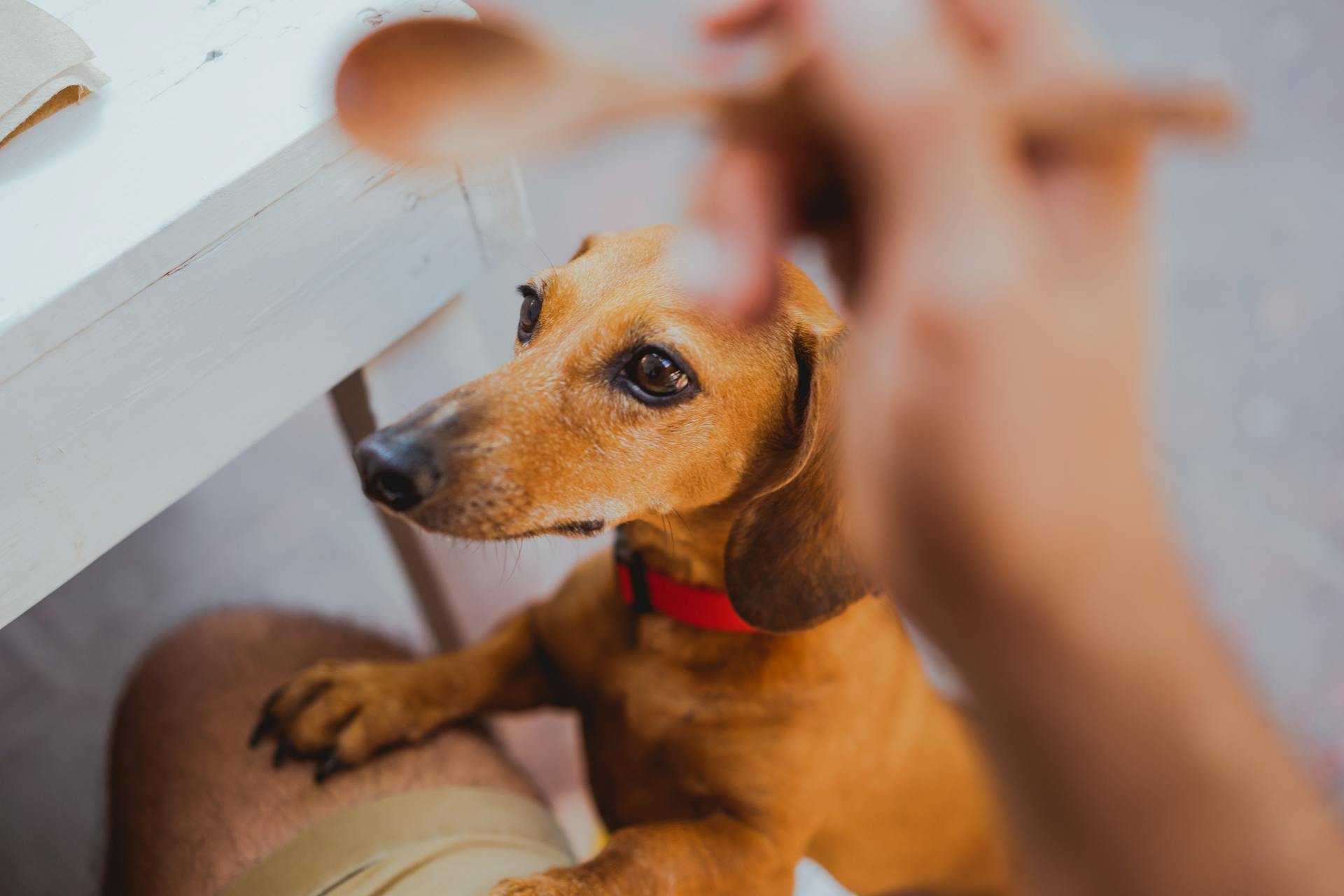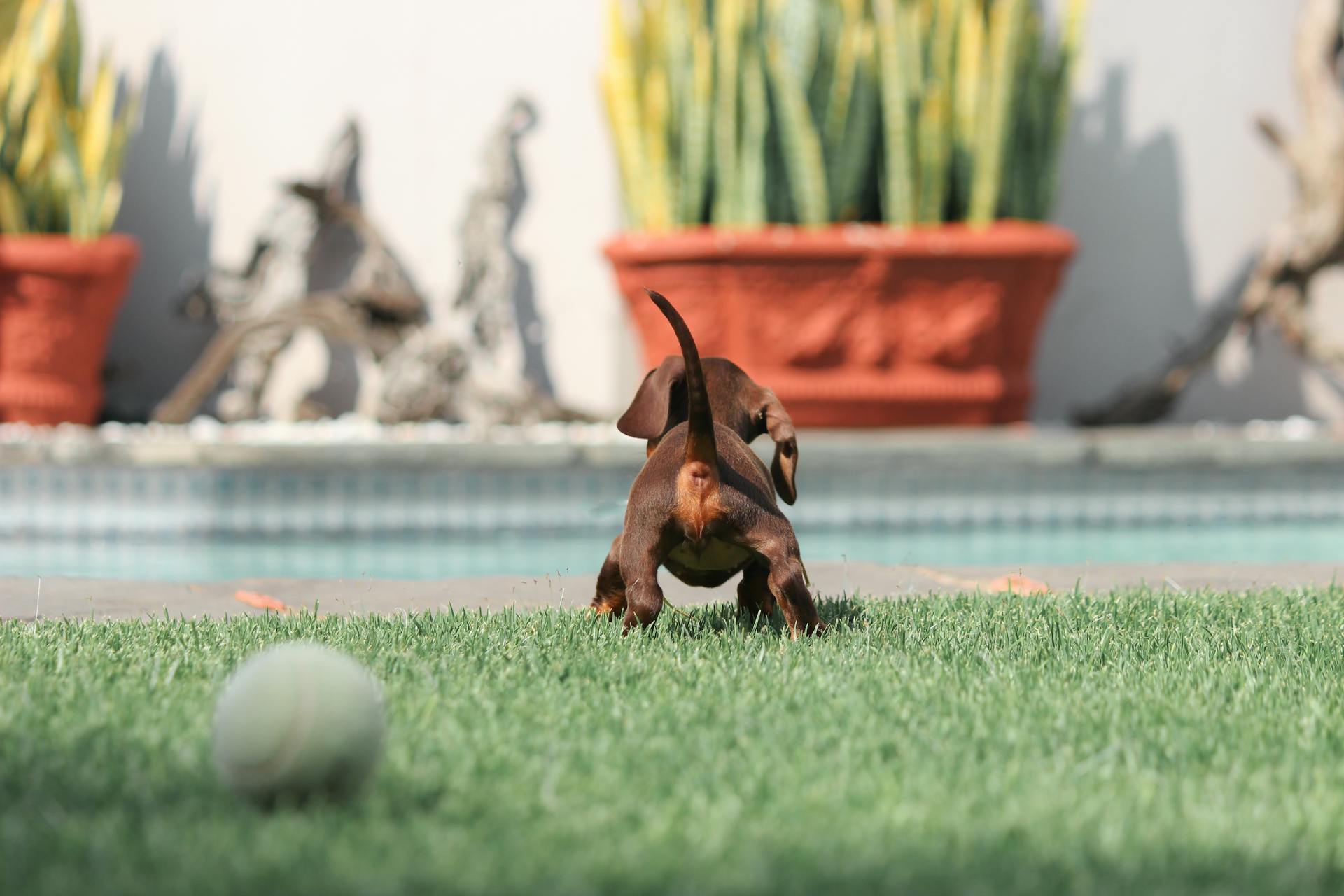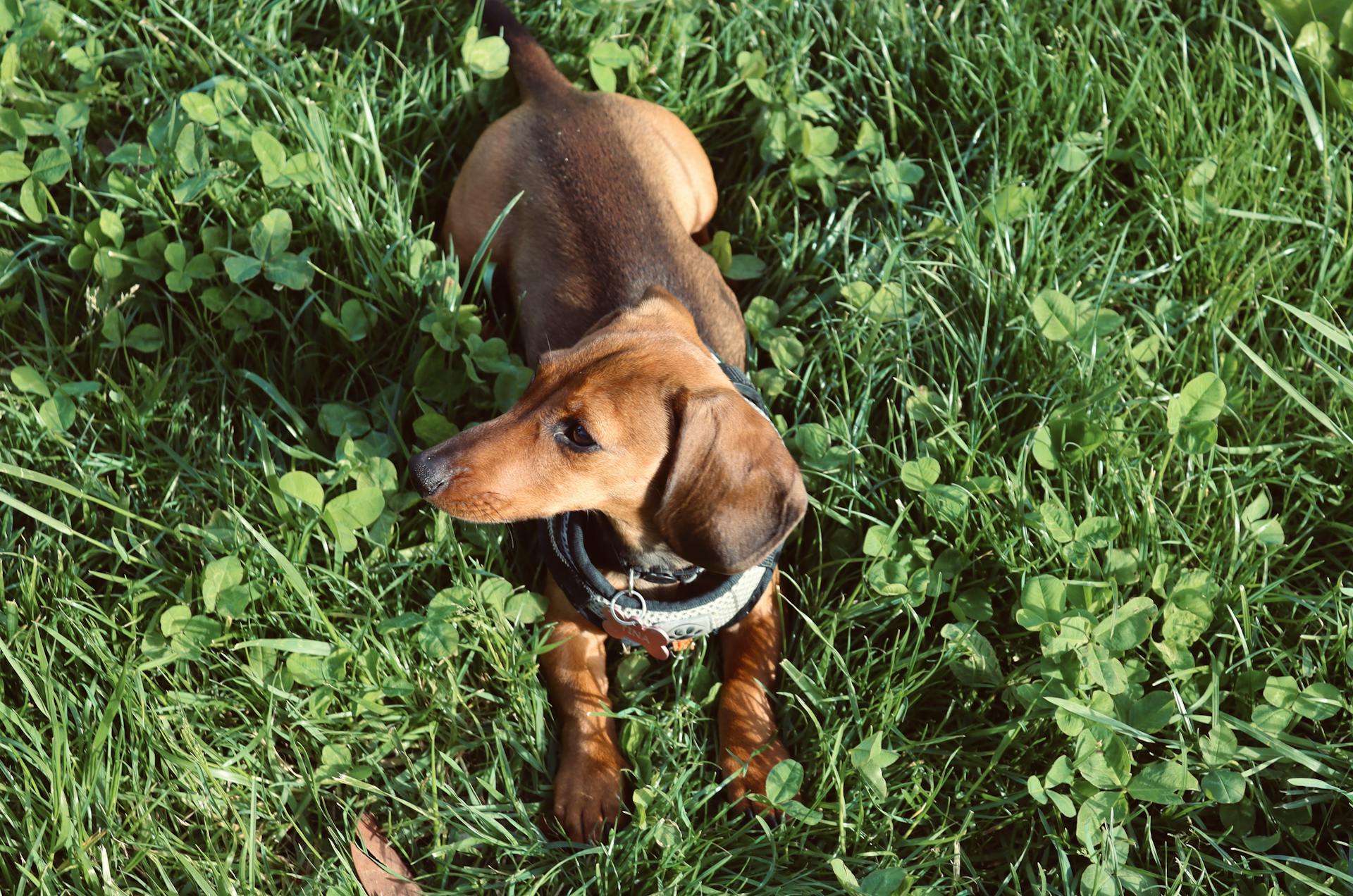
Wiener dogs, also known as Dachshunds, are intelligent and energetic companions that require consistent training to thrive.
Establishing a routine is crucial for wiener dog training, as they thrive on predictability and clear boundaries.
Housebreaking is a top priority, and wiener dogs can learn to go potty outside in as little as 4-6 weeks with positive reinforcement training.
Consistency is key when it comes to training wiener dogs, and setting aside a specific time each day for training can make all the difference.
Positive reinforcement techniques, such as treats and praise, can be used to encourage good behavior and discourage bad behavior.
Wiener dogs are naturally curious and love to explore, which can sometimes get them into trouble, so keeping an eye on them at all times is essential.
By following these simple steps and being patient with your wiener dog, you can help them become a well-behaved and loving companion.
If this caught your attention, see: Negative Reinforcement Dog Training
Understanding Wiener Dog Temperament
Wiener dogs can be quite the handful, especially when it comes to barking. They LOVE to bark, and will often announce every little thing to the world.
Their big bark for a little dog can get really annoying, but the good news is that this behavior can be changed with the right training. With patience and practice, you can teach your wiener dog to only bark at things that actually matter.
Wiener dogs are naturally brave and will often take on animals much bigger than themselves. This can sometimes get them into trouble, but with the right training, they can learn to restrain their "big dog in a little body" tendencies.
One of the biggest challenges of training a wiener dog is their intelligence and stubbornness. They can be quite willful and independent, making them one of the most challenging dogs to train.
Here are some common difficulties you may encounter while training your wiener dog:
- Loud barking
- Obsessive digging
- Proneness to attack
- Time-consuming potty training
Don't worry, though - with the right approach and patience, you can overcome these challenges and bring out the best in your wiener dog.
Common Behavior Problems
Dachshunds are naturally inclined to dig due to their breeding history as badger hunters. This tendency can be a challenge for owners.
Their signature shape and instinct to chase animals in holes in the ground can lead to digging in the backyard. It's a common problem to deal with.
You can't always be there to catch your dachshund in the act of digging, but there are ways to address the issue. Sneakily watching them from a distance, either out the window or via a camera, can help.
Setting up a digging zone, like a sandpit, can be a good solution. This allows your dachshund to express their natural tendencies without causing problems in your backyard.
A different take: Are Weiner Dogs and Dachshunds the Same
Training Commands
Training commands with your wiener dog requires patience and consistency. If your training session isn't going as planned, go back to the command your Dachshund learned before and end your session in a positive way.
To start, the Sit command is a great place to begin. Have two tablespoons of dog training treats cut into small pieces ready to go. Position your dog directly in front of you and hold the treat at nose level, then slowly move it to the back of their head.
Related reading: Back to Basics Dog Training
If your dog sits, praise with "Good" and give a small treat. If they don't sit, give a gentle push on their hindquarters to help them sit. Repeat this process a couple of times, and if they don't seem to get it, stop and try again later.
To make training more engaging, use positive reinforcement by giving treats and praise the moment your dog performs the desired command. This keeps them happy and engaged.
Sit
Training your Dachshund to sit is a great place to start. This command is a foundation for many other commands, and it's relatively easy to teach.
To begin, have about two tablespoons of dog training treats cut into small pieces and ready to go. You'll need these to reward your dog for good behavior.
Position your dog directly in front of you. Hold the treat at nose level and slowly move it to the back of their head. This will encourage them to sit.
If your dog sits, verbally praise with "Good" and give a small treat. If they don't sit, give a gentle push on their hindquarters to help them sit.
Repeat this process a couple of times. If they don't seem to get it, stop and try again later. This is normal, and patience is key.
To phase out the treats, start to hold the treat a little further away from their head. Eventually, you'll only need to say the word "Sit" and your dog will respond.
Here's a summary of the steps:
- Position your dog directly in front of you.
- Hold the treat at nose level and slowly move it to the back of their head.
- Verbalize "Good" and give a treat when they sit.
- Repeat the process until they learn the command.
Remember to praise and reward your dog the moment they perform the desired command. This is the key to positive reinforcement and keeping them happy and engaged.
Lay Down
To teach your Dachshund to lay down, start by having them in the "Sit" position. Sit on the floor in front of your dog with your Dachshund in the "Sit" position.
Hold a treat in front of their nose and move it down to the ground, starting to go under their chest. If your pup lays down, say "Good" and give a treat.
A unique perspective: Position Box Dog Training
Repeat this process until your pup lays down a couple of times in a row. Gradually increase the time they're laying down from a couple of seconds to about 8-10 seconds, practicing this a couple of times per day for about 2-3 minutes per session.
You can also add a hand motion to your verbal "down" command, such as pointing your index finger down and lowering it to the floor.
On a similar theme: Dog Training down
Stay
The "Stay" command is a fundamental part of any dog's training, and it's especially important for Dachshunds who can be prone to wandering off.
Teaching a Dachshund to Stay can be broken down into two parts, each taking a week to complete. Start by having your dog in the "Sit" position, facing you, and show them a stop sign with your palm. Say "Stay" and count 2 seconds, then praise and reward them with a treat if they stay.
You'll want to gradually increase the count to 3 seconds, 4, 5, and so on, up to 30 seconds. Practice this for a week, then move on to the second part of the training.
In the second part, have your dog in the "Sit" position, then take a few steps backwards while saying "Stay". If they stay, walk back towards them, praise, and reward with a treat.
Here's a rough guide to help you track your progress:
Remember to take your time with the second part and gradually increase the distance and time your dog needs to stay. With patience and practice, your Dachshund will learn to stay in no time!
Come
The "Come" command is one of the most essential training commands for any dog owner. It's a versatile command that can be used in various situations, from calling your dog back to you in a park to having them follow you in a busy street.
This command is often taught to dogs as a recall, meaning they learn to come back to their owners immediately. In the article, we learned that the "Come" command can be taught using positive reinforcement, such as treats and praise.
To teach your dog the "Come" command, start by having them on a leash and calling them to you. As soon as they reach you, reward them with a treat and praise.
Explore further: Back Problems in Dachshunds
Housebreaking and Confinement
Confine your puppy to a crate where they sleep and eat, and they'll likely keep themselves clean. The crate should be small, as dogs don't like to pee or poop in the same place they sleep and eat.
Confinement can be useful in potty training as puppies understand limits on where they can or can't go. However, don't use confinement to punish your pup, as it can instill fear and make them nervous.
Puppies don't like to pee or poop in the same place they sleep and eat, so a small crate can be an effective way to keep them clean.
Most of us train our dogs to jump up on furniture, but for dogs, couches and beds are very high compared to their size.
On a similar theme: Training a Small Dog
Training Techniques
Use rewards to motivate your wiener dog. The trick is to always have a treat at hand and praise them whenever they shine.
Doxies have a short attention span, so it's essential to keep them focused. Give them a treat or praise immediately after they finish, while they're still at their bathroom spot.
Use yummy and flavourful treats to make a relation between the word and the action much faster. Some options can be found on the top 10 best dog dental chews list, which are easy to digest and adored by dogs.
Here's an interesting read: Why Use a Clicker for Dog Training
Touch
Training your dog to touch is a great way to establish a strong bond and lay the foundation for more complex commands. To start, sit on the floor with your pup in front of you.
The key is to make it fun and engaging for your dog. Have your treats cupped in one hand, hiding them behind your back.
Show your empty hand to your dog, palm out, fingers facing down. This will help them associate the hand signal with the action.
If your dog touches your palm, praise with "Good" and give a treat. This positive reinforcement will encourage them to repeat the behavior.
Repeat this process several times before moving on to the next step. It's essential to keep the exercises short and fun to keep your dog engaged.
Once your dog gets the hang of it, say "touch" when you present your hand to them. This will help them learn the command and associate it with the action.
Broaden your view: Hand Signal for Sit Dog

To keep things interesting, change up your position and your hands occasionally. This will prevent your dog from getting bored and keep them guessing.
Here's a simple step-by-step guide to get you started:
- Sit on the floor with your pup in front of you.
- Have your treats cupped in one hand, hiding them behind your back.
- Show your empty hand to your dog, palm out, fingers facing down.
- If your dog touches your palm, praise with "Good" and give a treat.
- Repeat several times before moving on.
- Say "touch" when you present your hand to your dog.
- Change up your position and your hands occasionally.
Use Rewards
Using rewards is a simple yet effective way to train your Dachshund. Praise your dog immediately after they finish an action, as this will help them associate the action with the reward.
To make the association even faster, use yummy and flavorful treats that your dog loves. In fact, some of the best dog dental chews are perfect for this purpose.
Dachshunds have a short attention span, so keep training sessions short and sweet. If you're feeling bored, take a newspaper or book with you to keep yourself entertained.
Here are some tips for choosing the perfect treats:
- Choose treats that are easy to digest.
- Avoid using the worst dog treat brands.
- Use treats that your dog finds irresistible.
By using rewards effectively, you'll be able to train your Dachshund quickly and efficiently. So, get those treats ready and start training!
Behavioral Issues
Dachshunds are prone to digging due to their breeding history as badger hunters, which means they have a natural instinct to dig and chase animals that live in holes.
Their tendency to dig can be challenging to deal with, especially since it often happens when you're not around. This makes it hard to teach them not to do it.
You can tackle this issue by setting up a digging zone, such as a sandpit, and teaching them to only dig there. This way, they can express their natural tendencies without causing problems for you.
Additional reading: Natural State Dog Training
Problem #1: Digging
Digging is a natural behavior for Dachshunds, bred to chase badgers that live in holes in the ground. This instinctual behavior can wreak havoc in your backyard.
Dachshunds tend to dig when you're not around, making it challenging to teach them not to do it. Sneakily watching them, either out the window or via a camera, can help you catch them in the act and teach them that digging isn't acceptable.
Setting up a digging zone, like a sandpit, can give your Dachshund an outlet to express their natural tendencies without causing issues for you. However, this should only be done if your dog is already a digger, as encouraging a habit that didn't exist before can create more problems.
With the right training approach, you can make progress in training your Dachshund to stop digging in your backyard.
Problem: Barking
Barking is a common issue with dachshunds, as they tend to think the world needs to be notified about every little noise they hear.
Dachshunds can be trained to stop barking at every little noise, but the commonly recommended strategies of ignoring them or telling them "quiet" often don't work.
They were bred for badger hunting and tend to overreact to everyday stuff like people, dogs, and car noises.
This means they're often prone to being more reactive and aggressive than they need to be as a pet dog.
A fresh viewpoint: Training Dog to Stop Barking
With the right training, you can help them tell the difference between real threats and just regular life stuff, making everyone's life more relaxed and enjoyable.
Dachshunds can be stubborn and independent, and will happily take on "threats" much larger than themselves.
Their breed history of going down holes to hunt badgers contributes to their tendency to overreact to noises and situations.
You might like: Real Life Dog Training
Separation Anxiety
Dachshunds are prone to separation anxiety, which can lead to destructive behavior in the house.
Their instinct to be with their pack, or family members, makes it hard for them to be left alone.
Dachshunds who suffer from separation anxiety will act out due to their instinct, not because of any behavioral issues.
Punishing them for this behavior won't help, and can even make things worse.
Positive reinforcement training is the way to go, helping your Dachshund learn that you'll be back and they don't need to worry.
By providing them with separation anxiety training, you can help them feel more secure and calm when you're away.
You might like: Do Dog Diapers Help with Potty Training
I Unknowingly Encouraged My Dog's Bad Behavior
I unknowingly encouraged my dog's bad behavior without even realizing it. Most mainstream dog trainers base their philosophy on outdated principles that are ineffective.
These so-called "professionals" spread misinformation, teaching pet owners to use force and painful tools like choke and prong collars. This teaches your dog to avoid pain rather than learning to communicate effectively.
Many Dachshund owners are blindsided by inaccurate information, compromising their integrity and the trust of their puppy. This causes immense stress and anxiety in their pets, slowing down training progress and leading to behavioral problems.
It took me months of research to distinguish the right way to train my Dachshund from the wrong. I wish I had known the truth from the start to prevent behavioral problems from developing.
These key training principles are so powerful that I was able to reverse behavioral issues within weeks.
A fresh viewpoint: Shih Tzu Toilet Training Problems
Getting Started
You can start training your Dachshund as early as 8-10 weeks old. This is a great age to begin teaching basic commands that will set the foundation for a well-behaved adult dog.
Begin by reinforcing those early lessons throughout your Dachshund's life, and you'll be amazed at how quickly they pick up new skills.
For your interest: Begin the Bond Dog Training
When to Start

You can start training a Dachshund as early as 8-10 weeks old. This is a great time to begin teaching basic training commands that will serve them well throughout their life.
At this young age, Dachshunds are like sponges, soaking up new information and skills with ease. They'll pick up on commands like "sit" and "stay" in no time.
You can keep reinforcing those skills throughout their senior years, so don't worry if your Dachshund doesn't grasp something right away. Consistency and patience are key when it comes to training.
Ultimate Step-by-Step Guide
Getting started with your new furry friend can be overwhelming, but don't worry, I've got you covered. Dachshunds require a lot of exercise to stay happy and healthy, so make sure to take them on regular walks and playtime.
Dachshunds are prone to obesity, so monitor their food intake and adjust it accordingly. A balanced diet is crucial for their overall health.
To maintain your Dachshund's health, it's essential to schedule regular check-ups with your veterinarian. This will help prevent long-term problems.
Dachshunds can be prone to back problems due to their unique body shape, so it's crucial to provide them with a comfortable and supportive living space.
Additional reading: It's Your Choice Dog Training
Get to Know

Dachshunds are intelligent, loving, and loyal companions. They can be stubborn and defiant at times, but understanding their personality is key to smooth house training.
Their small size belies their big hearts, and with the right approach, you can build a strong bond with your Dachshund.
Here are some things to pay attention to as you get to know your Dachshund:
- They can be prone to separation anxiety and nervousness.
- They may exhibit destructive behavior if not properly housebroken.
- They can be prone to taking over the bed, climbing on furniture, and snatching food off the table.
- They may dig obsessively to hide possessions or roll in dirt and poop.
By understanding these traits, you can tailor your approach to meet their needs and avoid common behavioral problems. With patience and consistency, you can build trust and strengthen your relationship with your Dachshund.
Owner's Guide
The key to successful wiener dog training lies in understanding your Dachshund's unique body language and responding to their needs. This is crucial for building a strong bond and achieving obedience.
To get started, it's essential to recognize that Dachshunds respond to simple voice commands, hand gestures, and positive reinforcement methods. Effective communication is the foundation of any successful training program.
You can learn how to use these techniques to put a stop to your Dachshund's bad habits and save thousands on property damage due to destructive behavior. By doing so, you'll be able to strengthen your relationship with your dog and enjoy a more harmonious living environment.
Here are some essential areas to focus on when training your Dachshund:
- House-training, handling accidents, and regression
- Proper nutrition and exercise to keep your puppy happy and healthy
- Key training principles and techniques for accelerated progress
- Understanding your Dachshund's body language, facial expressions, and vocals
By covering these fundamental aspects, you'll be well on your way to raising a happy, healthy, and obedient Dachshund.
Debunking Breed Trait Myths
Adopting an adult dachshund dog can be a good way to know what you're getting, as they've already developed their traits.
Some dachshunds may not show their true personality until they get more comfortable, just like humans tend to only show their best side during the "honeymoon phase".
Puppies can change a lot as they grow up, so it's essential to familiarize yourself with the characteristics of your dog's breed.
Dachshunds within the same litter can vary hugely in personality, so breed isn't a guarantee that you'll get a certain "type" of dog.
Meeting both parents and seeing how closely they fit the traits you want your dachshund puppy to have as an adult can increase the chances of getting a dog with those traits.
If the parents are quite different, there's a higher chance that your puppy could have traits you don't want.
Puppies who hide in the corner or are overconfident can be signs of potential issues as adult dogs, so it's essential to temperament test them.
A confident, outgoing puppy may not always be the best choice if you want a dog who's "easy" to handle.
Additional reading: Leash Training Older Dog
Owner's Guide Became My Solution
I was struggling to find reliable dog training information that was easy to understand and implement. Dachshund 101: Owner's Guide became the solution I was looking for. It's a comprehensive guide that helps pet owners overcome common behavioral problems.
Broaden your view: Guide Dog Training
The guide addresses issues like obsessively digging to hide possessions, separation anxiety, and destructive behavior from lack of housebreaking. These are just a few examples of the many behavioral problems that Dachshund owners face.
Dachshund 101: Owner's Guide can help you overcome these problems by providing simple and modern training methods. It's a valuable resource that can save you time and frustration.
Here are some of the behavioral problems that the guide can help you address:
- Obsessively digging to hide possessions
- Separation anxiety and nervousness
- Destructive behavior from lack of housebreaking
- Running away, ignoring 'come' command
- Taking over the bed like he owns it
- Climbing on & damaging furniture
- Rolling in dirt and poop (gross)
- Swallowing socks and other dangerous objects
- Persistently pulling on the leash during walks
- Snatching food off the table and counter-tops
The guide is available in a digital format, making it easy to access on-the-go. This is especially important because it allows you to prevent behavioral problems from developing or recurring.
Frequently Asked Questions
How do you discipline a Dachshund?
Disciplining a Dachshund involves using positive reinforcement techniques, such as rewarding good behavior, and correcting bad behavior in a gentle and consistent manner
How long should I walk my Wiener dog?
For dogs under 6 months, a 30-minute daily walk is recommended, increasing to 45-50 minutes by 1 year. As your Dachsie matures, daily exercise needs can be tailored to your lifestyle, but a general guideline is 5 minutes of exercise per month of age.
Are Dachshund puppies easy to train?
Yes, Dachshund puppies are considered easy to train due to their intelligence and eagerness to please. With positive reinforcement and motivation, they can quickly learn and follow instructions.
What age should I start training a Dachshund puppy?
Start training your Dachshund puppy as soon as possible, ideally from the moment you bring them home, to take advantage of their highly absorbent young minds. Early training sets the foundation for a well-behaved and well-adjusted adult dog.
Featured Images: pexels.com


